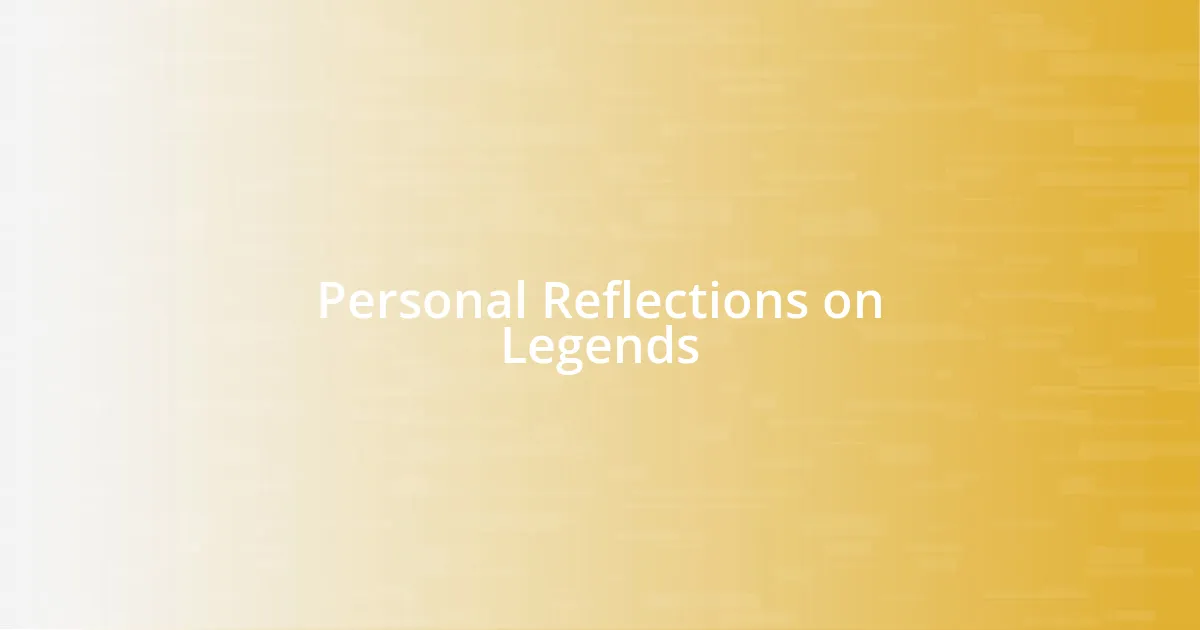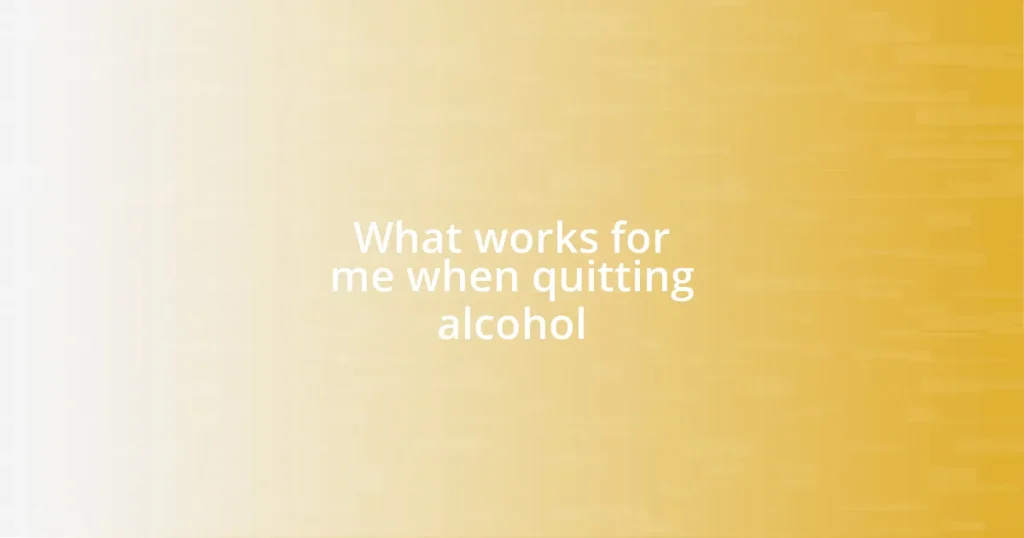Key takeaways:
- Drinking legends reflect cultural beliefs, serving as both captivating stories and cautionary tales about alcohol’s social impact.
- These legends foster community bonds, enhancing shared experiences and reinforcing social norms surrounding drinking.
- Common themes in drinking tales include communal drinking, the balance between revelry and reflection, and the transformation effects of alcohol.
- Personal reflections on these legends help individuals navigate their own relationships with alcohol, offering insights into their motivations and choices.

Understanding Drinking Legends
Drinking legends often reflect cultural beliefs and social practices deeply rooted in history. I remember the first time I heard the tale of the fabled drink that could make anyone who consumed it irresistible. It got me thinking: what makes these stories so captivating? Perhaps it’s the mix of mystery and the human desire for connection through shared experiences.
These legends can also serve as cautionary tales. For instance, I once witnessed the aftermath of a night fueled by the myth of “liquid courage.” It was a fine line between celebration and chaos, leaving me pondering: do these stories warn us about the more dangerous aspects of drinking? Personally, it made me reflect on how social pressure can shape our relationship with alcohol.
Moreover, drinking legends can foster a sense of community. I cherish the nights spent trading stories with friends about how this or that drink brought about unforgettable adventures. It sparks an exciting conversation about our own lives—what anecdotes do you hold dear? These exchanges remind us that while the legends are fascinating, it’s our personal narratives that truly make the experience memorable.

Cultural Significance of Drinking Tales
Drinking tales weave themselves into the fabric of our cultural identities, often narrating societal norms and values surrounding alcohol consumption. I’ve found that sharing these stories during celebrations or gatherings can foster deeper connections among people. They reveal not only what we enjoy but also how we see ourselves within our communities.
- In Spain, for example, the tradition of toasting with “salud” embodies a cultural emphasis on health and well-being.
- In Ireland, the stories shared over a pint often revolve around friendship and storytelling, emphasizing the importance of community.
- My experience at a local beer festival highlighted how these legends can transform strangers into friends as we bonded over shared tales and laughter.
Each tale I hear or share adds another layer to my understanding of how alcohol shapes our cultural landscape, reminding me of the bonds formed and lessons learned across generations.

Types of Drinking Legends
Drinking legends can be categorized into several types, each offering unique insights into human behavior and societal norms. For instance, heroic legends often recount tales of individuals who have overcome great odds while under the influence. I remember a friend recounting how a local hero allegedly drank a mystical brew to win a championship. It made me think about how these stories glorify drinking as an avenue for courage and strength, reflecting our admiration for those who dare to cross boundaries.
Conversely, cautionary tales serve as warnings from one generation to the next. From personal experience, I recall the stories told by my grandparents about reckless drinking leading to regretful decisions. It’s fascinating how these legends instill a sense of caution while also creating space for reflection on our choices. They remind us that while the allure of a drink can be strong, the consequences can loom larger.
Finally, there are whimsical legends that focus on the lighter side of drinking culture. I still chuckle at the tale my friends often share about a mythical drink that supposedly grants the ability to communicate with animals. It sparked a lively discussion one evening about what we would ask a dog or a cat if we could. These humorous narratives often lighten the mood and help build camaraderie as we laugh about the absurdity of it all, pulling us closer together.
| Type of Legend | Description |
|---|---|
| Heroic Legends | Tales showcasing individuals achieving greatness through drinking, embodying courage and strength. |
| Cautionary Tales | Stories that warn against reckless drinking, highlighting its potential consequences and lessons learned. |
| Whimsical Legends | Light-hearted narratives that inspire laughter, often involving fantastical drinks or outcomes. |

Analyzing Common Themes
When I analyze common themes in drinking legends, I often find that they serve a dual purpose: they entertain while offering insight into human nature. Take legends about communal drinking, for instance. I still remember a night spent sharing tales with friends around a campfire. Each story not only revealed something about our shared experiences but also created an unspoken bond, reminding me how potent those moments can be in solidifying friendships.
Another theme that leaps out is the dance between revelry and reflection. I’ve encountered tales that oscillate between joyous celebrations and somber realizations about the impact of alcohol. For example, I recall a local folklore that speaks about the spirit of a beloved tavern keeper who would cheerfully serve drinks but tragically succumb to his own indulgence. It left me wondering, how do these stories balance the highs of pleasure with the sobering lows of reality? They seem to encourage us to enjoy life but also prompt us to heed caution—like a gentle nudge reminding us of our vulnerabilities.
Finally, I find that many legends encapsulate the idea of transformation. In one story that never fails to elicit a chuckle, a clumsy drinker turns into a graceful dancer after one too many rounds. It makes me wonder: can drinking really change us in surprising ways? This theme resonates deeply with my own experiences at celebrations, where laughter often leads to unexpected moments of joy and creativity, illustrating how alcohol can blur the lines of our everyday selves, if only for a while.

Interpreting the Symbolism
Interpreting the symbolism behind drinking legends is like peering into the collective psyche of society. Take, for instance, the symbolism of toasting. I often think back to special occasions where we raised our glasses high and expressed our hopes for the future. It’s not just a gesture; it’s a ritual that brings us together, imbuing shared moments with significance. What does it say about us that we find a deeper meaning in this simple act? It suggests our innate desire for connection and celebration.
Then, there’s the symbolism of the drink itself. In many cultures, certain beverages symbolize status or tradition. I remember attending a wedding where the couple chose to serve a family recipe. The drink became a vessel of memory, connecting everyone to their roots. It made me realize that drinking legends often transcend mere consumption; they can become cultural artifacts that tell the story of who we are—past, present, and future.
Lastly, the role of intoxication in these legends cannot be underestimated. Many tales glorify the uninhibited behavior that often accompanies drinking. I think about my own adventures during college nights out, where a single drink could transform a shy individual into a social butterfly. This raises a question: is the freedom we feel under the influence authentic, or is it a reflection of societal constraints that bind us? These legends capture that exhilarating yet precarious balance between freedom and consequence, urging us to explore the complexities of our own motivations.

Practical Applications of Legends
Legends often serve practical purposes in our lives, acting as cautionary tales or sources of inspiration. I recall a friend of mine who cherished a drinking legend that emphasized moderation. Whenever he felt overwhelmed at parties, he would nod to the tale of a wise elder, known for sipping slowly and savoring each taste. This story became his guiding principle, reminding him that it’s not about how much you drink, but how deeply you engage with the moment. Doesn’t it make you think about your own choices in social situations?
Moreover, these legends can build communal identity and shared values. I think back to gatherings where specific stories circulated, reinforcing our group norms about drinking. For instance, there was a fable about a local hero who emerged stronger from cleverly navigating the pitfalls of a drunken night. This sparked discussions among us about responsibility and resilience. Aren’t we all looking for guidelines to navigate the complexities of our social lives?
Additionally, drinking legends can also be harnessed as tools for personal reflection. I remember one particularly moving story about a legendary figure who found clarity through drunken musings. As I pondered my own experiences, I began assessing the moments when alcohol led me to deeper insights about my life. It got me wondering: could our own drunken thoughts hold the key to understanding our inner selves? These legends encourage us to view our experiences through a lens of growth, inviting us to learn from both our revelries and mistakes.

Personal Reflections on Legends
Drinking legends have a special way of connecting us to our past and each other. I vividly remember a summer barbecue where tales of a mysterious drinker shaped our night. We shared stories about an old friend whose legendary mishaps taught us the importance of knowing our limits. I couldn’t help but wonder, how many of us carry these stories as cautionary tales, shaping our choices long after the initial sip?
Reflecting on these legends also stirs up nostalgia for simpler times. I often think back to my college days, hanging out in a cramped apartment, laughing while recounting a friend’s infamous spill at a party. In that moment, the drink wasn’t just about what was in our cups; it became a thread weaving us together, transforming a clumsy stumble into a cherished memory. Isn’t it fascinating how these shared experiences linger in our minds, forming the backbone of our social fabric?
Ultimately, the exploration of drinking legends can be quite introspective, pushing me to consider my own relationship with alcohol. I recall a night when I raised a glass to commemorate a personal victory, feeling a rush of pride. I questioned if I was toasting to genuine joy or using the drink as a crutch for celebrating my achievements. Does our reliance on these rituals reveal a deeper insecurity? These reflections deepen my understanding of not just the legends but also my own motivations behind every toast and drink shared among friends.















